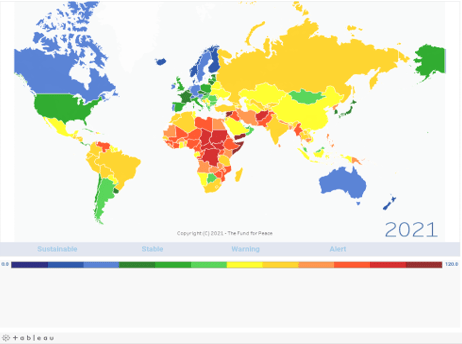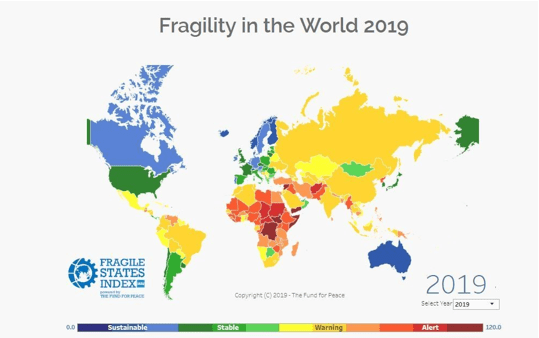As per the broad definition given by the Department for International Development (DFID), state fragility refers to a situation “where the government cannot or will not deliver core functions to the majority of its people, including the poor.” However, the phenomenon of fragility is too complex, with plenty of contextual intricacies to be confined to one universal definition. State Fragility can manifest itself in multiple ways and to various extents, and its nature can be widely relative to the specific context. It can be limited to a particular region or exist at a sub-national level as well. Additionally, fragility is fluid that can vary based on the intensity of its drivers, and states can often move in and out of the situation of fragility. Nonetheless, fragile states can be loosely defined as the weak or distressed states where the inefficiency or failure of the government in providing essential services, including justice, security, public goods, etc. leads to the perpetual existence of the humanitarian crisis, conflicts, and a situation of persistent instability that leaves the citizens more vulnerable to be exposed to various shocks and trapped in the cycle of poverty.

Source: World Economic Forum

Source: Fragile States Index
While it is challenging to delineate state fragility in a definite manner, several attributes or characteristics are defined by the international actors such as World Bank (WB) and International Monetary Fund (IMF) that help identify the fragile states. According to the World Bank (WB), countries are classified as fragile if they have a score below 3.0 as per the Country Policy and Institutional Assessment (CPIA) index of the World Bank or a presence of UN
peacekeeping or a displacement across borders of 2,000 or more per population of 100,000. Similarly, the attributes on the rationalisation of which the Fund For Peace (FFP) labels a country as fragile includes challenged sovereignty and failure to exercise control over its territories, deterioration of the legitimate authority’s ability to make collective decisions, failure to provide rudimentary services to its citizens and incompetence in interacting with other states as a full member of the international community. FFP has also developed a critical tool known as the Fragile States Index (FSI) based on a conflict assessment framework- CAST that measures the state’s vulnerability to failure. It is an annual report that uses a set of twelve conflict risk indicators such as cohesion, political, economic, and social indicators to assess the condition of a country at any given moment. The simple conclusion of all these defined characteristics and attributes is that a state can be considered to have attained fragility when it fails its people.
Although state fragility has ossified its presence in different world regions, it is not naturally occurring. Instead, it is driven by several different agents. Weak institutions can be the central driving force for state fragility and economic decline, external shocks, political manipulation of natural resources, and violent conflicts. (Vallings and Moreno-Torres, 2005). All these factors are self and mutually reinforcing and can bring instability within a state in divergent ways. However, conflict-driven fragility is very interesting because violence and conflict are not only instruments that result in state weakness, but they can also exaggerate the intensity of the impact of other already existing contributors of fragility. Violent conflicts can destabilise a state in multiple manners, including but not limited to political, economic, and social ways. Civil wars are the most prevalent form of violent conflicts that put states under extreme strain and force them to divert their attention towards the crisis, which weakens state institutions, rendering them incapable of providing people with essential services.
Moreover, conflicts can manifest themselves in economic shocks because they lead to a reduced level of GDP due to the lack of production and corresponding declined investments. Social tensions can also heighten as a consequence of wars in which the existing societal inequalities get highlighted, and the manipulation of citizens by politicians and social groups becomes convenient. (Vallings and Moreno-Torres, 2005). All these factors that are encompassed in violent conflicts drive the states towards a situation of fragility.

Source: Fragility State Index
The most unfiltered and direct impact of conflict-driven state fragility is definitely on its citizens, who are at the receiving end of the negative sequences of wars. Violent conflicts are translated into deplorable living conditions, unavailability of basic needs, inaccessibility of health and education, and prolonged mental illness. The destruction of infrastructure halts the distribution of education and healthcare facilities, leaving the citizens to grapple with illiteracy and untreated mental and physical illnesses, which become a lifelong burden for them. There are various studies conducted in different war-affected parts of the world that explore these impacts. For instance, a study conducted in Arab countries to assess the impact of wars and conflicts on the general population’s mental health revealed that Post-Traumatic Stress Disorder (PTSD) and Major Depression Disorder were the psychological complications found most commonly among Arabs. (Al-ghzawi et al., 2014). Similar studies on the impact of wars have also concluded that the long-term impacts of wars continue to haunt the survivors and leave them in a chronic state of distress.

Source: State Fragility Index
With the general understanding of state fragility, its characteristics, drivers, and consequences, it is imperative to conceptualize a way out of fragility. The first step should be to not ignore fragile states as the lost causes because although these are some of the toughest and complex environments with persistent weakness at multiple levels, it is possible to rectify the humanitarian crisis, eradicate poverty and stimulate economic growth in these contexts with the aid of developed countries and international donors. The Department for International Development (DFID) has also previously produced an analysis on making development and progress more effective in fragile contexts. According to that, there needs to be a development of better early warning systems and delivering aid properly and effectively. Also, building an understanding of the political economy of the state and acknowledging the importance of regional relationships and institutions, improved donor coordination, and combining aid with technical assistance, trade policy, and human rights monitoring, are crucial to help the distressed states. Conclusively, there needs to be an international action combined with effective monitoring and evaluation to help in strengthening the fragile states.
This article exclusively represents the author’s views and research, not the position of The Youth Center for Research.
About the author: Mukti is a visiting Research Fellow at the Youth Center for Research and a third-year student at Habib University, majoring in Social Development and Policy.
BIBLIOGRAPHY
Al-ghzawi, H. M., ALBashtawy, M., Azzeghaiby, S. N., & Alzoghaibi, I. N. (2014). The impact of wars and conflicts on mental health of Arab population. International Journal of Humanities and Social Science, 4(6), 237-242.
Classification of Fragile and Conflict-Affected Situations. World Bank. (2021, July 1). https://www.worldbank.org/en/topic/fragilityconflictviolence/brief/harmonized-list-of-fragile-situations.
Fragile States Fail Their Citizens and Threaten Global Security. United States Institute of Peace. (2019, February 21). https://www.usip.org/blog/2018/09/fragile-states-fail-their-citizens-and-threaten-global-security.
Vallings, C., & Moreno-Torres, M. (2005). Drivers of fragility: What makes states fragile? (No. 668-2016-45529).
What Does State Fragility Mean? Fragile States Index. (n.d.). https://fragilestatesindex.org/frequently-asked-questions/what-does-state-fragility-mean/.
Why we Need to Work More Effectively in Fragile States. Department for International Development. (2005). https://gsdrc.org/document-library/why-we-need-to-work-more-effectively-in-fragile-states/
Author: Mukti Prem Chand
Dated: 16th July 2021


